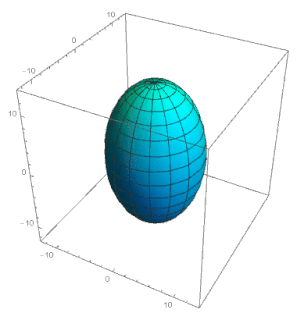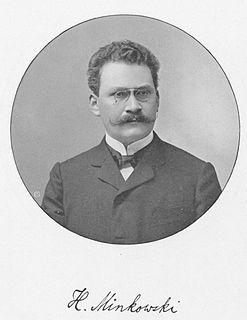 W
WIn general relativity, an exact solution is a solution of the Einstein field equations whose derivation does not invoke simplifying assumptions, though the starting point for that derivation may be an idealized case like a perfectly spherical shape of matter. Mathematically, finding an exact solution means finding a Lorentzian manifold equipped with tensor fields modeling states of ordinary matter, such as a fluid, or classical non-gravitational fields such as the electromagnetic field.
 W
WA Belinski–Khalatnikov–Lifshitz (BKL) singularity is a model of the dynamic evolution of the universe near the initial gravitational singularity, described by an anisotropic, chaotic solution of the Einstein field equation of gravitation. According to this model, the universe is chaotically oscillating around a gravitational singularity in which time and space become equal to zero. This singularity is physically real in the sense that it is a necessary property of the solution, and will appear also in the exact solution of those equations. The singularity is not artificially created by the assumptions and simplifications made by the other special solutions such as the Friedmann–Lemaître–Robertson–Walker, quasi-isotropic, and Kasner solutions.
 W
WA de Sitter universe is a cosmological solution to the Einstein field equations of general relativity, named after Willem de Sitter. It models the universe as spatially flat and neglects ordinary matter, so the dynamics of the universe are dominated by the cosmological constant, thought to correspond to dark energy in our universe or the inflaton field in the early universe. According to the models of inflation and current observations of the accelerating universe, the concordance models of physical cosmology are converging on a consistent model where our universe was best described as a de Sitter universe at about a time seconds after the fiducial Big Bang singularity, and far into the future.
 W
WIn general relativity, a dust solution is a fluid solution, a type of exact solution of the Einstein field equation, in which the gravitational field is produced entirely by the mass, momentum, and stress density of a perfect fluid that has positive mass density but vanishing pressure. Dust solutions are an important special case of fluid solutions in general relativity.
 W
WIn general relativity, a fluid solution is an exact solution of the Einstein field equation in which the gravitational field is produced entirely by the mass, momentum, and stress density of a fluid.
 W
WThe Friedmann–Lemaître–Robertson–Walker metric is an exact solution of Einstein's field equations of general relativity; it describes a homogeneous, isotropic, expanding universe that is path-connected, but not necessarily simply connected. The general form of the metric follows from the geometric properties of homogeneity and isotropy; Einstein's field equations are only needed to derive the scale factor of the universe as a function of time. Depending on geographical or historical preferences, the set of the four scientists – Alexander Friedmann, Georges Lemaître, Howard P. Robertson and Arthur Geoffrey Walker – are customarily grouped as Friedmann or Friedmann–Robertson–Walker (FRW) or Robertson–Walker (RW) or Friedmann–Lemaître (FL). This model is sometimes called the Standard Model of modern cosmology, although such a description is also associated with the further developed Lambda-CDM model. The FLRW model was developed independently by the named authors in the 1920s and 1930s.
 W
WThe Gödel metric is an exact solution of the Einstein field equations in which the stress–energy tensor contains two terms, the first representing the matter density of a homogeneous distribution of swirling dust particles, and the second associated with a nonzero cosmological constant. It is also known as the Gödel solution or Gödel universe.
 W
WIn Einstein's theory of general relativity, the interior Schwarzschild metric is an exact solution for the gravitational field in the interior of a non-rotating spherical body which consists of an incompressible fluid and has zero pressure at the surface. This is a static solution, meaning that it does not change over time. It was discovered by Karl Schwarzschild in 1916, who earlier had found the exterior Schwarzschild metric.
 W
WThe Kasner metric is an exact solution to Albert Einstein's theory of general relativity. It describes an anisotropic universe without matter. It can be written in any spacetime dimension and has strong connections with the study of gravitational chaos.
 W
WThe Kerr metric or Kerr geometry describes the geometry of empty spacetime around a rotating uncharged axially-symmetric black hole with a quasispherical event horizon. The Kerr metric is an exact solution of the Einstein field equations of general relativity; these equations are highly non-linear, which makes exact solutions very difficult to find.
 W
WThe Kerr–Newman metric is the most general asymptotically flat, stationary solution of the Einstein–Maxwell equations in general relativity that describes the spacetime geometry in the region surrounding an electrically charged, rotating mass. It generalizes the Kerr metric by taking into account the field energy of an electromagnetic field, in addition to describing rotation. It is one of a large number of various different electrovacuum solutions, that is, of solutions to the Einstein–Maxwell equations which account for the field energy of an electromagnetic field. Such solutions do not include any electric charges other than that associated with the gravitational field, and are thus termed vacuum solutions.
 W
WLemaître coordinates are a particular set of coordinates for the Schwarzschild metric—a spherically symmetric solution to the Einstein field equations in vacuum—introduced by Georges Lemaître in 1932. Changing from Schwarzschild to Lemaître coordinates removes the coordinate singularity at the Schwarzschild radius.
 W
WIn mathematical physics, the Lemaître–Tolman metric is the spherically symmetric dust solution of Einstein's field equations. It was first found by Georges Lemaître in 1933 and Richard Tolman in 1934 and later investigated by Hermann Bondi in 1947. This solution describes a spherical cloud of dust that is expanding or collapsing under gravity. It is also known as the Lemaître–Tolman–Bondi metric or the Tolman metric.
 W
WThe Milne model was a special-relativistic cosmological model proposed by Edward Arthur Milne in 1935. It is mathematically equivalent to a special case of the FLRW model in the limit of zero energy density and it obeys the cosmological principle. The Milne model is also similar to Rindler space, a simple re-parameterization of flat Minkowski space.
 W
WIn mathematical physics, Minkowski space is a combination of three-dimensional Euclidean space and time into a four-dimensional manifold where the spacetime interval between any two events is independent of the inertial frame of reference in which they are recorded. Although initially developed by mathematician Hermann Minkowski for Maxwell's equations of electromagnetism, the mathematical structure of Minkowski spacetime was shown to be implied by the postulates of special relativity.
 W
WIn general relativity, the pp-wave spacetimes, or pp-waves for short, are an important family of exact solutions of Einstein's field equation. The term pp stands for plane-fronted waves with parallel propagation, and was introduced in 1962 by Jürgen Ehlers and Wolfgang Kundt.
 W
WIn physics and astronomy, the Reissner–Nordström metric is a static solution to the Einstein–Maxwell field equations, which corresponds to the gravitational field of a charged, non-rotating, spherically symmetric body of mass M. The analogous solution for a charged, rotating body is given by the Kerr–Newman metric.
 W
WIn general relativity, Schwarzschild geodesics describe the motion of test particles in the gravitational field of a central fixed mass that is, motion in the Schwarzschild metric. Schwarzschild geodesics have been pivotal in the validation of Einstein's theory of general relativity. For example, they provide accurate predictions of the anomalous precession of the planets in the Solar System and of the deflection of light by gravity.
 W
WIn Einstein's theory of general relativity, the Schwarzschild metric is an exact solution to the Einstein field equations that describes the gravitational field outside a spherical mass, on the assumption that the electric charge of the mass, angular momentum of the mass, and universal cosmological constant are all zero. The solution is a useful approximation for describing slowly rotating astronomical objects such as many stars and planets, including Earth and the Sun. It was found by Karl Schwarzschild in 1916, and around the same time independently by Johannes Droste, who published his much more complete and modern-looking discussion only four months after Schwarzschild.
 W
WIn cosmology, a static universe is a cosmological model in which the universe is both spatially and temporally infinite, and space is neither expanding nor contracting. Such a universe does not have so-called spatial curvature; that is to say that it is 'flat' or Euclidean. A static infinite universe was first proposed by English astronomer Thomas Digges (1546–1595).
 W
WThe Taub–NUT metric is an exact solution to Einstein's equations. It may be considered a first attempt in finding the metric of a spinning black hole. It is sometimes also used in homogeneous but anisotropic cosmological models formulated in the framework of general relativity.
 W
WThe two-body problem in general relativity is the determination of the motion and gravitational field of two bodies as described by the field equations of general relativity. Solving the Kepler problem is essential to calculate the bending of light by gravity and the motion of a planet orbiting its sun. Solutions are also used to describe the motion of binary stars around each other, and estimate their gradual loss of energy through gravitational radiation.
 W
WIn general relativity, the van Stockum dust is an exact solution of the Einstein field equation in which the gravitational field is generated by dust rotating about an axis of cylindrical symmetry. Since the density of the dust is increasing with distance from this axis, the solution is rather artificial, but as one of the simplest known solutions in general relativity, it stands as a pedagogically important example.